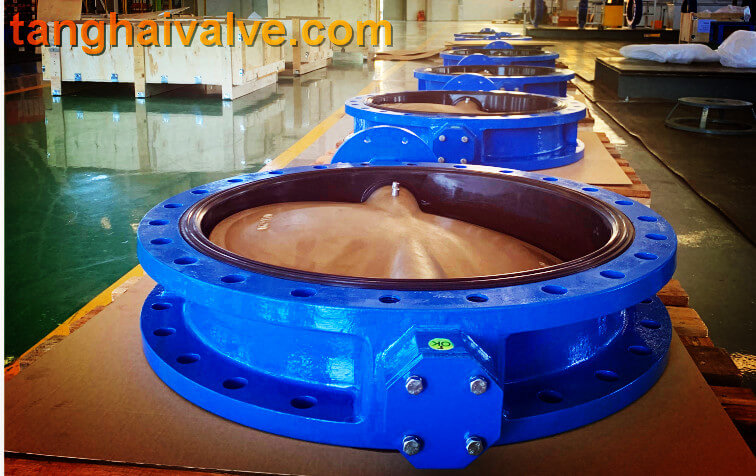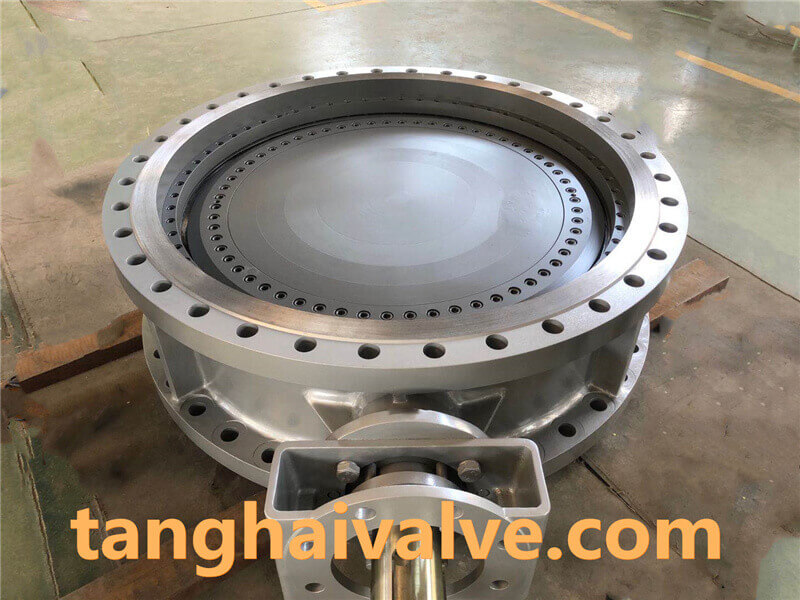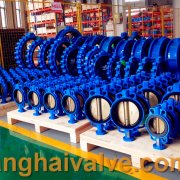Structural characteristics & features of flanged butterfly valves
The basic knowledge and structural characteristics of flange butterfly valves:
The flanged butterfly valve has introduced a self-sealing design concept, in which the connection between the disc and the valve shaft adopts a patented pull-out pin structure. The main features of the valve are reliable sealing, bi-directional sealing, and tight connection without loosening, so that the valve can be used for a long time. Its characteristics are as follows:

Double flange butterfly valve (16)
Two-way sealing
Generally, traditional butterfly valves cannot be sealed well under the working pressure in the opposite direction (not conducive to the sealing direction) due to their structural reasons. At present, the relevant national standards do not have mandatory regulations for two-way sealing. This is because:
1. Adopting the self-sealing design concept. The disc sealing ring is directly embedded in the disc in a zigzag shape with rubber, and there is no need to use pressure rings or bolts to fix, thus avoiding the uneven force of the sealing ring caused by the traditional bolt pressure plate type seal, which makes the bolts The problem of falling off and premature damage to the sealing ring. Under the action of the working pressure in the opposite direction, the sealing ring generates self-sealing force, which increases the specific pressure of the seal. The sealing ring compresses the valve seat. The greater the working pressure in the opposite direction, the greater the self-sealing force, so that the sealing ring and the valve seat The combination is tight to achieve the effect of two-way sealing.

triple offset butterfly valve-double flange- (4)
2. The disc has good rigidity and is not easy to deform. The disc of butterfly valve above DN300 is a double-plate truss flow-through structure, with small flow resistance and good rigidity. Under the working pressure in the opposite direction, it is not easy to deform, so that the sealing ring will not follow the disc Deformed and separated from the best sealing point of the valve seat, thus ensuring the sealing effect of the sealing ring.
3. Long life of rubber sealing ring
(1) Due to the self-sealing design concept, the small interference between the rubber ring and the stainless steel valve seat only maintains the initial seal, so the specific pressure required for the seal increases with the increase of the system pressure.
(2) In addition, there is a so-called “breathing” groove for rubber elastic retreat in the zigzag groove, so that the rubber has a certain expansion space when it is under pressure, so that it will not produce elastic fatigue during long-term work, so it is sealed The life of the ring is greatly increased compared with the traditional type.
Patent design withdrawal pin structure
Usually in the process of using the butterfly valve, due to the traditional pin connection, the pin passes through the center of the valve shaft, which not only reduces the strength of the valve shaft, but also creates a gap between the valve shaft and the valve shaft during long-term use, which will cause an impact when the valve is opened and closed. Load, this load is much greater than the load generated by the extrusion stress and shear stress under normal conditions. Often the pin is severely deformed or broken during use, which makes the valve closed or fails, and greatly reduces the valve Service life. If the newly produced valve adopts the US patent design withdrawing pin structure to replace the pin connection structure between the shaft and the valve disc, the withdrawal pin does not pass through the center of the valve shaft, not only does not weaken the strength of the shaft, but also connects with the valve shaft. The fitting surface is greatly increased. By tightening the withdrawal pin nut, a pre-tightening force is generated between the withdrawal pin and the valve shaft joint surface, so that the disc valve shaft is tightly combined without gaps, and it will not be used when opening and closing the valve. The impact load is generated, so that the valve flap rotates smoothly, thereby realizing reliable sealing.
Unique design of the bottom axial adjustment and locking device
In butterfly valves above DN300, considering the reliability of the self-weight seal of the butterfly plate, the position of the disc on the valve seat is in the best sealing state through precise adjustment and fixation of the axial position during manufacturing. For the sagging of the valve clack that may be caused during long-term use, it is also convenient to further adjust the lock to achieve zero leakage in long-term use.
Easy to replace the sealing ring
When the sealing ring needs to be replaced, there is no need to remove the disc, just open the valve fully, and then take out the key from the operating device, after the operating device is adjusted to the closed state, it still maintains the key connection with the main valve, and then continues in the opening direction Turn the hand wheel until the sealing ring is on the side of the valve body sealing surface to replace the sealing ring.
Related knowledge: the principle of butterfly valve structure
Related products: Electric flanged butterfly valve Pneumatic flanged butterfly valve
TH Valve is a professional manufacturer of butterfly valve, gate valve, check valve, globe valve, knife gate valve, ball valve with API, JIS, DIN standard, used in Oil, Gas, Marine industry, Water supply and drainage, fire fighting, shipbuilding, water treatment and other systems, with Nominal Diameter of DN50 to DN1200, NBR/EPDM/VITON, Certificates & Approvals: DNV-GL, Lloyds, DNV, BV, API, ABS, CCS. Standards: EN 593, API609, API6D
Related news/knowledge:
Structural characteristics of butterfly valve;
Structural characteristics of metal hard seal butterfly valve;
The structural characteristics and uses of the wafer butterfly valve;
Electric globe valves’ structural features and installation attention

 tanghaivalve.com
tanghaivalve.com

 © Copyright 2020 Tianjin Tanghaidongyang Valve Co., Ltd. All Rights Reserved.
© Copyright 2020 Tianjin Tanghaidongyang Valve Co., Ltd. All Rights Reserved. tanghaivalve.com
tanghaivalve.com